Community Health Worker Program Expands in Mexico
Posted on Aug 1, 2014

Adelaida Lopez walks the red dirt roads of her community in Chiapas, Mexico, under the shade of an umbrella.
As a community health worker, Lopez visits her patients—who are also her neighbors—in their homes at least once a week. Suffering from chronic diseases, they need more support than what a doctor can give in a monthly check-up at the clinic. Lopez offers much more—someone to talk to, friendly advice on diet and exercise, and accompaniment to the clinic for regular visits.
Lopez is one of 26 community health workers, known as acompañantes, trained and employed by PIH’s sister organization in Chiapas, Compañeros En Salud. Over the next six months, PIH/CES is expanding the program to more communities, bringing these services to more people and studying the impact of community health workers on the health of patients with chronic diseases, conditions that can be controlled but not cured.
“The acompañantes (CHWs) are marvelous. They take such good care of the patients and make the treatment so much more effective,” said Dr. Hector Carrasco, community programs coordinator. He saw their impact firsthand last year, when he worked with a team of CHWs as a doctor in one of the remote clinics.
In Chiapas, PIH/CES has adapted PIH’s community health worker model from Haiti and Peru—developed for patients suffering from HIV and tuberculosis—to fit the rural communities in this mountainous coffee-farming region of southern Mexico. Here, CHWs are assigned to all patients with certain chronic diseases, which make up a huge proportion of disease affecting rural Mexicans.
In Mexico, hypertension affects about one in every three adults.
In Mexico, hypertension affects about one in every three adults, and only about half of those know their diagnosis, according to the Mexican government’s 2012 National Health and Nutrition Survey. Of diagnosed patients, only less than half have their blood pressure under control. Additionally, three out of four Mexicans with diabetes requires greater control of their blood sugar to avoid complications of their disease.
In the three communities where PIH/CES has established a community health worker program, any patient diagnosed with depression, hypertension, diabetes, epilepsy, or tuberculosis is assigned a CHW who lives near their home.
The CHWs make weekly visits, checking on their patients’ health, answering questions, and educating them about their health condition. For people with hypertension, the CHW might suggest they cut back on salt, or take a walk together. They can also talk to family members who may suffer from the same disease and encourage them to seek treatment.
CHWs act as a liaison between the doctor in the clinic and the patient, advocating for his or her care and informing the doctor if problems arise.
CHWs act as a liaison between the doctor in the clinic and the patient, advocating for his or her care and informing the doctor if problems arise. CHWs are compensated with packages of food, such as rice, beans, and pasta.
All the CHWs are women, for several reasons. In Chiapas, it’s more socially acceptable for a woman to visit a man at home than vice versa. Additionally, women have more flexible schedules because they work in the home more often than in the fields. And employing women promotes gender equity by providing an opportunity for education and employment outside the home.
“The acompañantes are very happy with what they’re doing,” Carrasco said. “It gives them another role to take care of their community.”
As part of the expansion, PIH/CES is studying the effect of CHWs on chronic disease. Because the program can’t expand to all six communities it serves at the same time, the team will expand to one of four new communities every three months. They evaluate the health of chronic disease patients before and after patients receive the support of CHWs, and can compare the status of patients from one community to another. This way, they will be able to evaluate the impact of CHWs on health without denying this care to anyone for the sake of research.
PIH/CES hopes the study’s results will help make a case to the Mexican Ministry of Health that the program should be expanded. Carrasco said there is no other program like it in Mexico.
“It’s not expensive, and it employs local people as resources,” Carrasco said. “This program is a beacon. It has the potential to become a model of excellence for chronic disease care in Mexico and beyond.”

